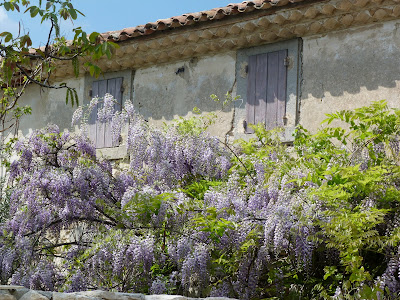The Luberon hills are like a great wide curtain, falling in folds created by steep gorges like a stage backdrop behind our land; all paths south through the property seem to end in ridged blue hills that deepen with the passing of the day. By early evening the folds are sharply delineated by black pleats, the crevasses that trap the dark.
~
As the great range of hills slumbered in evening shades of rust and indigo, we listened to jazz on the CD player.
From The Lantern
On summer evenings, as the sun sends slants of red light up the slopes from the west, it carves blood red clefts in the hills. In this soft light, the distinctive ripples across the valley have the visual texture of velvet.
This is the time to sit, perhaps with friends, and drink a glass of ice-cold rosé, and nibble black olives, feeling the warm evening settle, watching the folds in the hills turn into dark rivulets.
Music plays a large part in the life of this place. If Rob isn’t playing his piano in the courtyard music room, trying out new pieces – like Dom, in the novel - then an eclectic selection wafts through the air from iPods and CDs. Early evening is often the time for laid-back jazz. There’s something about the style that captures the essence of the South of France, and this recording with a beguiling slow beat, by Stacey Kent is just perfect.
It comes from the album Raconte-moi… (Tell me…). The songs, some new, some old, are all in French though Kent is American, married to the British musician Jim Tomlinson who is also her arranger and producer. They have been hugely successful in France over the past few years – the French have such good taste! Here, then, is one of my favourites, Désuets, which translates loosely as “old-fashioned things” with a hint of vintage and obsolescence.





























